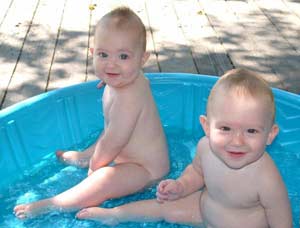In summer, when the weather is hot, respiratory illnesses tend to increase… So how can we best care for children during this time?
Avoiding drafts is “nurturing”… bacteria
 |
| Children should bathe in a sheltered area and avoid cold water (Photo: dnugent) |
According to Dr. Nguyen Van Loc, Deputy Director of the Central Children’s Hospital, a common misconception among parents when caring for children with fever, sore throat, or pneumonia during hot days is the idea of “completely avoiding drafts,” leading to days without bathing. In summer, the Central Children’s Hospital often receives children with complications such as otitis media and purulent meningitis, with the initial cause being… sore throat.
When children have sore throats accompanied by fever, parents are often “overly cautious” and go to great lengths to avoid sunlight and drafts, which increases the risk of bacterial infections. Hot weather combined with a lack of cleanliness creates an ideal environment for bacteria to thrive.
Bathing in cold water during summer is not actually a good health practice. Coming in from the hot sun, the body feels stuffy and overheated; if cold water is poured over the body too quickly, it causes blood vessels to constrict, trapping the high temperature that should be released back into the body, which can lead to fever. Therefore, children need to bathe in a sheltered area and should never be bathed in cold water.
Do not lower the temperature too much
National statistics on childhood illnesses show that bacterial infections are the leading cause of illness. Among these, respiratory infections account for the largest proportion, and the top cause of respiratory infections is viral pathogens (influenza virus, Adenovirus…). Currently, there is no definitive treatment for respiratory illnesses caused by viruses, so it is crucial to ensure full vaccination (influenza A vaccine) and isolate patients when multiple children are sick in the same neighborhood, classroom, or school. |
Typically, summer outdoor temperatures range from 35-36oC, and can sometimes be even higher. If the air conditioning temperature is set too low, it directly affects the body’s temperature regulation center in the brain. Transitioning from an environment of 21-22oC to the hot sun causes blood vessels to dilate, requiring the heart to work harder to regulate blood flow.
If blood flow cannot adjust quickly enough, it can lead to anemia, most commonly in the brain and heart, causing shock or fainting. For infants, maintaining body temperature is crucial. Whether in summer or winter, the ideal room temperature for infants should be between 27-30oC. Temperatures lower than this range can lead to conditions such as cutaneous edema in children.
In fact, just beneath the skin surface of infants, there exists a type of fatty acid that requires temperatures of 27oC or higher to dissolve; at lower temperatures, it solidifies, leading to edema. Consequently, infants may not be able to metabolize properly, which can lead to fatal outcomes. When sleeping, infants often kick off their blankets, so for homes with young children, an optimal room temperature of 27oC is essential to prevent sore throats, colds, and fevers, which could have long-term effects on their bronchial and lung health later on.
NGOC HA




















































